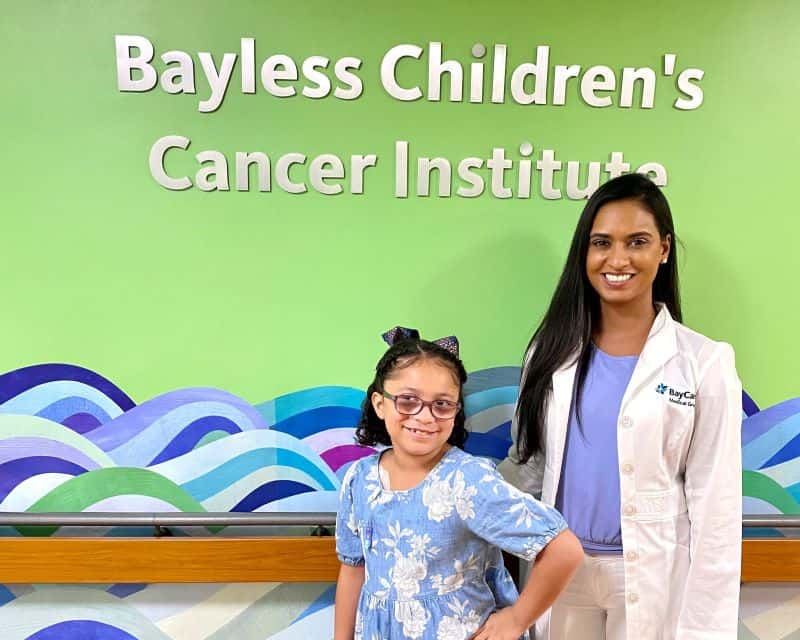Taming Tumors at St. Joseph’s Children’s Hospital in Tampa
Maria Fuentes was frustrated.
The family had just moved to Florida from New York, and, after a year of online classes, her three daughters, Emely (15), Kristyne (13) and Sophia (9) Carrasco-Fuentes were finally and happily back in person in their respective schools.

Looking for Things to Do in Tampa Bay?
>>This Week’s Favorite Events
>> Nearby U Pick Farms
>> 40+ Free Things to Do with Kids
But less than four hours into the day, here was a phone call from the school nurse saying that Sophia had been struck in the head by a rock thrown accidentally by another child.
A frustrated Maria took Sophia to the nearby St. Joseph’s Children’s Hospital to make sure she wouldn’t need stitches. The doctor felt that Sophia was fine but told her he’d like to do a CAT scan, just in case there was a hairline fracture.
No one could have anticipated what those scans showed: a tumor in Sophia’s brain, so large that it filled a quarter of her entire head.
“I was completely panicked,” Maria recalls.
It’s a nightmare scenario for any parent, but luckily for the Fuentes family, they had stumbled across the exact health care facility equipped to handle such a crisis. Just months prior to Sophia’s diagnosis, St. Joseph’s Children’s Hospital had hired Dr. Trisha Larkin—the only fellowship-trained pediatric neurooncologist in Hillsborough County—to set up a pediatric neuro oncology program here.
“Parents never know when they’ll need our service,” says Dr. Larkin. Brain cancer is the most common cause of solid cancer in children ages 0-14. There are hundreds of different types of brain cancers that can occur in children but because it is rare, most are not diagnosed until they’ve been showing symptoms such as headaches, seizures and vomiting for several months.
“Most families have never had to think about it,” Dr Larkin says. “So when we do find a brain tumor, we move fast and deliberately. Our pediatricians, pediatric neurosurgeons, intensive care physicians and I come together as a team. We’re all here for the child.”
St. Joseph’s Children’s Hospital’s pediatric neurosurgeons removed most of Sophia’s tumor, but a section that remained sat too close to the optic nerve for the doctors’ comfort. Enter Dr. Larkin with her arsenal of cutting-edge treatment. She explained that radiation could pose more risks than benefits to a young girl and proposed a chemotherapy infusion regimen instead. The chemo infusions worked on part of the tumor, but not all, so Dr. Larkin added a second chemo pill. Together, the treatments appear to be working—the tumors are shrinking.
“I really appreciate how Dr. Larkin was clear and straightforward,” Maria says. “She was so honest about the plan and the potential side effects. The recommendations have always been for Sophia’s benefit. When you hear the word cancer, the word tumor, you always think negatively. Dr. Larkin took all of that out of my head.”
As the first college student and physician in her family, Dr. Larkin understands medical jargon can be difficult to navigate. She spends time educating families so they can feel empowered when advocating for their child. That’s why she never hesitates to do the simplest things that can have a big impact, like picking up the phone and calling the child’s pediatrician to keep them in the loop.
In fact, teamwork is a huge part of what drew her to St. Joseph’s Children’s Hospital. The Central Florida native was happy to move back home after completing her advanced fellowship at St. Jude’s Children’s Research Hospital in Tennessee. She knew there was a need to serve the Tampa Bay community – while in Tennessee, she had treated numerous children who had to fly there from this area in Florida to get brain tumor care.
At St. Joseph’s Children’s Hospital, she found exactly what she was looking for: a world-class mix of diverse specialties and a collaborative approach that values innovation. A child can not only get a spectrum of services from oncology to surgery to neuropsychology and rehabilitation, but they can also participate in international clinical trials without leaving the Tampa Bay area. “Our knowledge about brain tumors has changed dramatically,” Dr. Larkin says. “We can now provide customized treatment plans specifically tailored to target the molecular makeup of the child’s tumor. Oftentimes, these are oral medications so the kids can still participate in school and their regular activities.” Technological advancements include features like 3D virtual reality navigation systems and interoperative MRIs that help guide the neurosurgeons during surgery to maximize outcomes.
Dr. Larkin’s team is also setting up a specialized clinic for neurocutaneous disorders in collaboration with local ophthalmologists and neurologists and other specialists to provide comprehensive care for children with conditions such as neurofibromatosis types 1 and 2. These kids sometimes have benign growths called plexiform neurofibromas that are not “cancers” but can shrink or even disappear with targeted oral medications.
She says that one of the biggest rewards of working with children is witnessing their incredible resilience, and Sophia is a prime example. Maria says that Sophia asked to see her scans right from the start and participates in every decision, including whether or not to receive anesthesia before a scan. She’s in a hurry to recover, do her physical therapy to get her full range of movement back on her left side, and get back to making videos and becoming a famous YouTuber.
“Nothing really gets her down,” Maria says. “She just makes you feel happy. If she can be brave and have the courage to go through this and happy and positive, how can I not?”
*Presented by BayCare | Originally published in the June 2022 issue of Tampa Bay Parenting Magazine.





